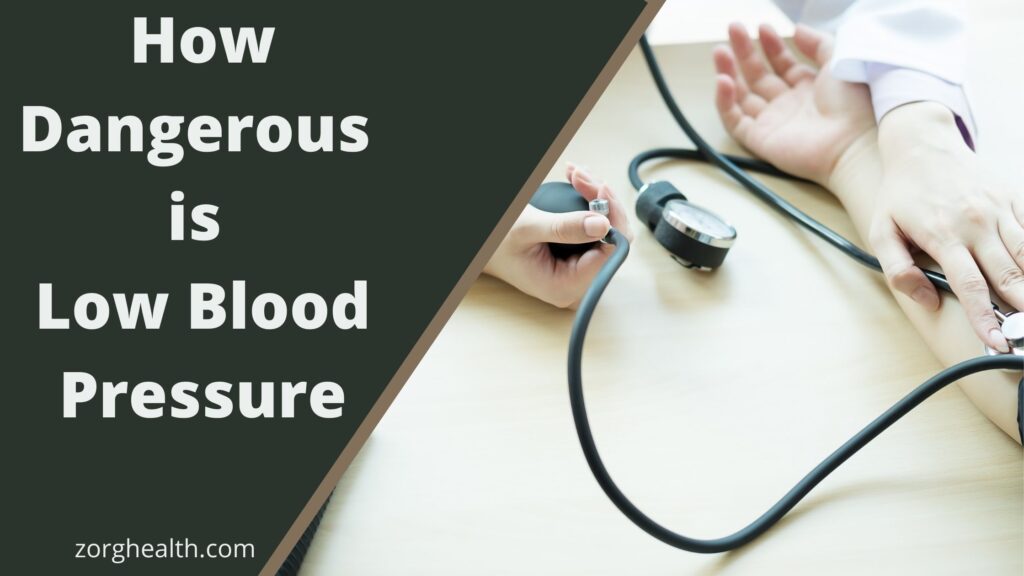It is said that low blood pressure (BP) is actually a good thing for the heart unless you are having symptoms. BP lower than 90 mmHg (millimeters of mercury) for top reading and/ or lower than 60mmHg for bottom reading is considered low BP. Although low BP might not cause any problem in some people, it is very important to know how dangerous is low Blood Pressure as it can even be life-threatening sometimes.

What is blood pressure?
The heart pumps blood throughout the entire body, and at the same time constantly adjust and balance our blood pressure to ensure all body parts receive enough blood and oxygen so that there is no danger from low BP. This blood constantly exerts pressure on the arteries with every heartbeat. This force against the artery walls is called blood pressure.
A normal (or optimal) blood pressure is considered between 100/60 and 120/80 and can somewhat fluctuate throughout the day. The National Heart, Lung, and Blood Institute define low blood pressure (aka hypotension) as under 90/60 mm Hg.
Everyone’s blood pressure varies naturally throughout the day depending on the person’s physical activity levels and diet and other underlying conditions. It is lowest while a person is sleeping or resting and much higher during physical activity, in the mornings, or during stressful times.
What happens when Blood Pressure is low?
In a person with low blood pressure, the blood flows through the veins and arteries with too little force. However, it might be a cause for concern when normal or high blood pressure suddenly becomes low blood pressure leading to worrisome symptoms and even serious health problems.
Low blood pressure can be a life-threatening health condition in severe cases. Its common symptoms of dizziness and fainting have the potential to upset daily life and tend to get worse with age.
It starts showing symptoms when enough blood is not reaching the organs to carry its normal functions, impairing heart and brain functions and even causing difficulty in breathing.
Therefore, depending on the severity of the drop of blood pressure, the condition can suddenly become a cause of immediate medical attention where the organs shut down making the person lose consciousness or leading to a stroke, heart attack, shock, or kidney failure.
How to recognize low Blood Pressure?
Following are some of the common symptoms of low blood pressure:
- Fatigue
- Dizziness
- Dehydration
- Nausea
- Light-headedness
- Fainting
- Blurry vision
- Clammy skin or sweating
- Depression
- Feeling cold/thirsty
- Breathing issues
According to a study published in the Journal of the American Geriatrics Society, elderly patients with low blood pressure may be more likely to have symptoms of depression.
However, there can be patients without any symptoms to have low pressure.
Low Blood Pressure and High pulse rate
If your blood pressure is low then your organs become deprived of oxygen, to rectify that heart rate increases to push more amount of blood to the body. This leads to low BP and a high heart rate. It can lead to a few symptoms like nausea, headache, dizziness, mental clouding, fear due to palpitations (awareness of own heartbeat), and rarely chest pain.
What are the reasons for low Blood Pressure?
The causes can be due to several health conditions. Some are temporary and can be easily fixed while others can be long-term and needs medical treatment. The cause of low blood pressure isn’t always clear and might be associated with the following:
- Quick physical movements (example, standing)
- Dehydration
- Eating disorders
- Dietary deficiencies (nutrient deficiency such as low vitamin B12, iron, and folic acid)
- Serious medical disorders (example, stroke, severe blooding, heart problems, hormonal problems, neural disorder, endocrine problems, Addison’s disease)
- Prolonged inactivity (example, bed rest)
- Experiencing a shocking event or feeling suddenly afraid
- Serious injury
- Heart arrhythmias (abnormal heart rhythms)
- Widening, or dilation, of the blood vessels
- Straining
- Severe infections that enter the bloodstream (example, Septicemia)
- Allergic reactions (Anaphylaxis)
- Heat exhaustion or heat stroke
- Pregnancy
- Stress level
- Medications you take
- Alcohol trigger
It’s important to find out what’s causing your low blood pressure so that it can be treated.
Treatment to Manage Low Blood Pressure or Hypotension
Talking to your doctor about the specific and persistent symptoms experienced is crucial to align to the appropriate and timely line of treatment. Depending on the case, the patient may just need to make some dietary and lifestyle adjustments or may need treatment for a shock to prevent damage to the brain and other organs due to dangerously low Blood pressure.
Depending on the severity of the condition of low pressure, the medical advisor will suggest a treatment line. In many cases, patients with low pressure do not need treatment, However, in case of abrupt hypotension or when it’s related to an underlying health condition, an appropriate treatment plan is advised by the doctor to save you from the danger of low BP.
Doctors may want to monitor the symptoms and test the blood pressure themselves to make any necessary diagnosis and administer treatment.
Making some simple dietary and lifestyle habits is considered an effective way to treat low blood pressure.
What should be the diet for low blood pressure
- Drink more water and fluids regularly to keep yourself hydrated
- Eat a diet rich in sodium (consult a doctor what’s right for you)
- Monitor your sugar levels
- Moderate alcohol intake to avoid dehydration
- Adjust eating habits by eating small, low-carb meals frequently. Rest after eating.
- Eat a balanced diet with a focus on vitamin B12, iron, and folic acid. (click here to know foods rich in vitamin B12, iron, and folic acid).
How Dangerous is Low Blood Pressure? Tips to avoid dangerous low BP
- Take regular breaks to move around to keep your muscles flexed.
- Watch your emotional or stress trigger situations when you feel too scared or emotional before a drop.
- Be mindful of your bodily movements. Change postures slowly and avoid sitting or standing or lying down for a long time.
- Monitor your sugar levels.
- Wear compression stockings to avoid blood pooling your legs.
- Get your thyroid checked regularly to be aware of if enough thyroid hormones are being produced.
- Treat your infections to avoid bacteria entering your bloodstream.
- Include exercise in your schedule to stimulate blood flow.
- Avoid lifting heavy stuff.
- Avoid prolonged exposure to hot water.
- Use an effective blood pressure monitor at home.
Blood pressure naturally fluctuates throughout the day.
Low pressure or hypotension conditions can happen to anyone depending on your age and underlying health conditions. A person should be aware of how dangerous is low blood pressure and the signs and symptoms of low blood pressure. So, be aware of your symptoms, learn your triggers, if you have them, and how to manage them.
